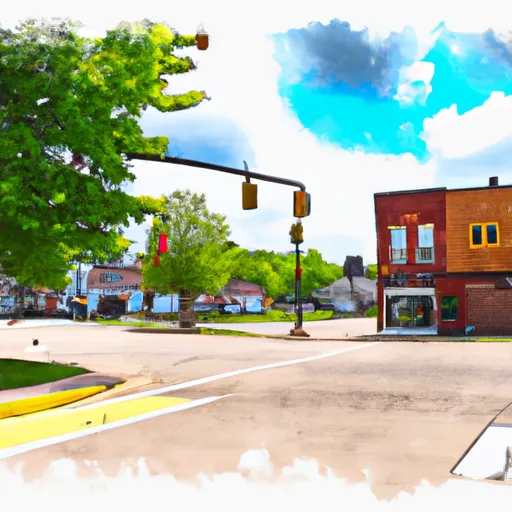-
 Snoflo Premium
Snoflo Premium
Get unlimited access to all our content
With no Ad interruptions! - Start Your Free Trial Login with existing account
Milford
Eden Index
Climate
8.7
•
Recreation
6.6
•
Community
3.7
•
Safeguard
6.7/10

Milford, Michigan, located in Oakland County, offers a picturesque small-town charm with its beautiful landscapes and outdoor recreational opportunities. The climate in Milford is considered humid continental, with warm summers and cold winters. Summers bring average temperatures around 80°F, while winters can be quite chilly, with temperatures dropping to around 20°F. Milford experiences moderate rainfall throughout the year, with occasional snowfall during the winter months.
The town is surrounded by numerous lakes and rivers, making it perfect for water-based activities. The Huron River, flowing through Milford, offers canoeing, kayaking, and fishing opportunities. Additionally, the nearby Kensington Metropark boasts a large lake, providing boating, swimming, and picnicking options. The park also features nature trails, perfect for hiking and biking enthusiasts.
Milford is known for its abundant green spaces and parks, such as Central Park and Hubbell Pond Park, which offer walking paths, playgrounds, and picnic areas. Additionally, Proud Lake State Recreation Area, located just outside of Milford, provides campgrounds, hiking trails, and a sandy beach for swimming.
Overall, Milford, Michigan, offers a pleasant climate, beautiful hydrological features, and a wide range of outdoor recreational opportunities, making it an attractive destination for nature lovers and outdoor enthusiasts.
What is the Eden Index?
The Snoflo Eden Index serves as a comprehensive rating system for regions, evaluating their desirability through a holistic assessment of climate health, outdoor recreation opportunities, and natural disaster risk, acknowledging the profound impact of these factors on livability and well-being.
Climate Health Indicator (CHI): 8.7
Milford receives approximately
797mm of rain per year,
with humidity levels near 77%
and air temperatures averaging around
9°C.
Milford has a plant hardyness factor of
5, meaning
plants and agriculture in this region thrive during a short period during spring and early summer. Most
plants will die off during the colder winter months.
By considering the ideal temperature range, reliable water supplies, clean air, and stable seasonal rain or snowpacks, the Climate Health Indicator (CHI) underscores the significance of a healthy climate as the foundation for quality living.
A healthy climate is paramount for ensuring a high quality of life and livability in a region, fostering both physical well-being and environmental harmony. This can be characterized by ideal temperatures, reliable access to water supplies, clean air, and consistent seasonal rain or snowpacks.
Weather Forecast
Streamflow Conditions
St. Clair-Detroit
Area Rivers
St. Clair-Detroit
Snowpack Depths
St. Clair-Detroit
Reservoir Storage Capacity
St. Clair-Detroit
Groundwater Levels
Recreational Opportunity Index (ROI): 6.6
The Recreational Opportunity Index (ROI) recognizes the value of outdoor recreational options, such as parks, hiking trails, camping sites, and fishing spots, while acknowledging that climate plays a pivotal role in ensuring the comfort and consistency of these experiences.
Access to outdoor recreational opportunities, encompassing activities such as parks, hiking, camping, and fishing, is crucial for overall well-being, and the climate plays a pivotal role in enabling and enhancing these experiences, ensuring that individuals can engage in nature-based activities comfortably and consistently.
Camping Areas
| Campground | Campsites | Reservations | Toilets | Showers | Elevation |
|---|---|---|---|---|---|
| Wayne County Fairgrounds RV | None | 691 ft | |||
| Bishop Lake - Brighton Rec Area | None | 901 ft | |||
| Proud Lake State Rec Area | 130 | 1,002 ft | |||
| Highland State Rec Area | 40 | 977 ft | |||
| Camp Dearborn | 191 | 934 ft | |||
| Pontiac Lake State Rec Area | 175 | 1,015 ft | |||
| Groveland Oaks County Park | None | 963 ft | |||
| Mary Jane Thurston State Park | 35 | 644 ft | |||
| Murray Lake - Brighton Rec Area | None | 875 ft | |||
| Appleton Lake - Brighton Rec Area | None | 888 ft |
Nearby Ski Areas
Catastrophe Safeguard Index (CSI):
The Catastrophe Safeguard Index (CSI) recognizes that natural disaster risk, encompassing floods, fires, hurricanes, and tornadoes, can drastically affect safety and the overall appeal of an area.
The level of natural disaster risk in a region significantly affects safety and the overall livability, with climate change amplifying these risks by potentially increasing the frequency and intensity of events like floods, fires, hurricanes, and tornadoes, thereby posing substantial challenges to community resilience and well-being.
Community Resilience Indicator (CRI): 3.7
The Community Resilience Indicator (CRI) recognizes that education, healthcare, and socioeconomics are crucial to the well-being of a region. The CRI acknowledges the profound impact of these elements on residents' overall quality of life. By evaluating educational resources, healthcare accessibility, and economic inclusivity, the index captures the essential aspects that contribute to a thriving community, fostering resident satisfaction, equity, and social cohesion.

